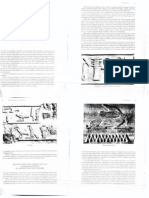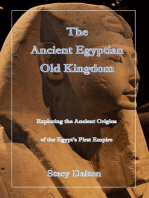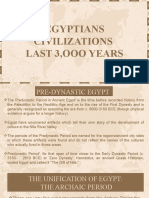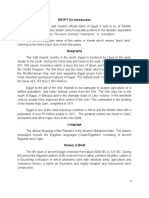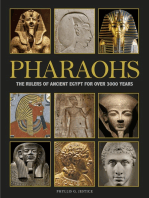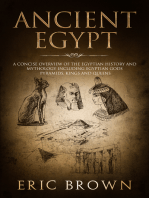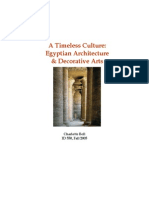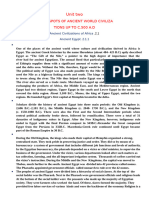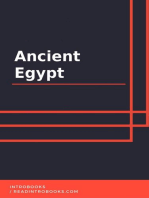Ancient Egypt
Ancient Egypt
Uploaded by
Marina KennedyCopyright:
Available Formats
Ancient Egypt
Ancient Egypt
Uploaded by
Marina KennedyOriginal Description:
Copyright
Available Formats
Share this document
Did you find this document useful?
Is this content inappropriate?
Copyright:
Available Formats
Ancient Egypt
Ancient Egypt
Uploaded by
Marina KennedyCopyright:
Available Formats
Ancient Egypt
Egypt's impact on later cultures was immense. You could say that Egypt provided the building blocks for Greek and Roman culture, and, through them, influenced all of the Western tradition.
Today, Egyptian imagery, concepts, and perspectives are found everywhere; you will find them in architectural forms, on money, and in our day to day lives. Many cosmetic surgeons, for example, use the silhouette of Queen Nefertiti (whose name means the beautiful one has come) in their advertisements.
Pyramid of Khafre at Giza, c. 2520-2494 (right). Photo: Dr Amy Calvert, CC BY-NC
This introduction will provide you with the primary filters to view and understand ancient Egypt.
Longevity Ancient Egyptian civilization lasted for more than 3000 years and showed an incredible amount of continuity. That is more than 15 times the age of the United States, and consider how often our culture shifts; less than 10 years ago, there was no Facebook, Twitter, or Youtube.
While today we consider the Greco-Roman period to be in the distant past, it should be noted that Cleopatra VII's reign (which ended in 30 BCE) is closer to our own time than it was to that of the construction of the pyramids of Giza. It took humans nearly 4000 years to build something--anything--taller than the Great Pyramids. Contrast that span to the modern era; we get excited when a record lasts longer than a decade.
Consistency & Stability Egypts stability is in stark contrast to the Ancient Near East of the same period, which endured an overlapping series of cultures and upheavals with amazing regularity.
The earliest royal monuments, such as the Narmer Palette carved around 3100 B.C.E., display identical royal costumes and poses as those seen on later rulers, even Ptolemaic kings on their temples 3000 years later.
Palette of Narmer, c. 3000-2920 B.C.E. (left) and Ramses III smiting at Medinet Habu(1160 B.C.E.) (right)
A vast amount of Egyptian imagery, especially royal imagery that was governed by decorum (a sense of what was appropriate), remained stupefyingly consistent throughout its history. This is why, especially to the untrained eye, t heir art appears extremely staticand in terms of symbols, gestures, and the way the body is rendered, it was. It was intentional. The Egyptians were aware of their consistency, which they viewed as stability, divine balance, and clear evidence of the correctness of their culture.
This consistency was closely related to a fundamental belief that depictions had an impact beyond the image itselftomb scenes of the deceased receiving food, or temple scenes of the king performing perfect rituals for the godswere functionally causing those things to occur in the divine realm. If the image of the bread loaf was omitted from the deceaseds table, they had no bread in the Afterlife; if the king was depicted with the incorrect ritual implement, the ritual was incorrect and this could have dire consequences. This belief led to an active resistance to change in codified depictions.
Painted raised relief offering table in the Temple of Seti I at Abydos (New Kingdom). Photo: Dr Amy Calvert, CC BY-NC
The earliest recorded tourist graffiti on the planet came from a visitor from the time of Ramses II who left their appreciative mark at the already 1300-year-old site of the Step Pyramid at Saqqara, the earliest of the massive royal stone monuments. They were understandably impressed by the works of their ancestors and endeavored to continue that ancient legacy.
Geography Egypt is a land of duality and cycles, both in topography and culture. The geography is almost entirely rugged, barren desert, except for an explosion of green that straddles either side of the Nile as it flows the length of the country. The river emerges from far to the south, deep in Africa, and empties into the Mediterranean sea in the north after spreading from a single channel into a fan-shaped system, known as a delta, at its northernmost section. The influence of this river on Egyptian culture and development cannot be overstatedwithout its presence, the civilization would have been entirely different, and most likely entirely elsewhere. The Nile provided not only a constant source of life-giving water, but created the fertile lands that fed the growth of this unique (and uniquely resilient) culture.
View from the high peak of the Theban hills showing the sharp delineation between the lush Valley and the barren desert. Photo: Dr Amy Calvert, CC BY-NC
Each year, fed by melting snows in the far-off headlands, the river overflowed its banks in an annual flood that covered the ground with a rich, black silt and produced incredibly fertile fields. The Egyptians referred to this as Kemet, the black lands, and contrasted this dense, dark soil against the Deshret, the red lands of the sterile desert; the line between these zones was (and in most cases still is) a literal line. The visual effect is stark, appearing almost artificial in its precision.
Time - Cyclical and Linear The annual inundation of the Nile was also a reliable, and measurable, cycle that helped form their concept of the passage of time. In fact, the calendar we use today is derived from one developed by the ancient Egyptians. They divided the year into 3 seasons: akhet inundation, peret growing/emergence, andshemw harvest. Each season was, in turn, divided into four 30-day months. Although this annual cycle, paired with the daily solar cycle that is so evident in the desert, led to a powerful drive to see the universe in cyclical time, this idea existed simultaneously with the reality of linear time. These two conceptsthe cyclical and the linearcame to be associated with two of their primary deities: Osiris, the eternal lord of the dead, and Re, the sun god who was reborn with each dawn.
Early Development: The Predynastic Period The civilization of Egypt obviously did not spring fully formed from the Nile mud; although the massive pyramids at Giza may appear to the uninitiated to have appeared out of nowhere, they were founded on thousands of years of cultural and technological development and experimentation. Dynastic Egyptsometimes referred to as Pharaonic (after pharaoh, the Greek title of the Egyptian kings derived from the Egyptian title per aA, Great House) which was the time when the country was largely unified under a single ruler, begins around 3100 B.C.E.
The period before this, lasting from about 5000 B.C.E. until unification, is referred to as Predynastic by modern scholars. Prior to this were thriving Paleolithic and Neolithic groups, stretching back hundreds of thousands of years, descended from northward migrating homo erectus who settled along the Nile Valley. During the Predynastic period, ceramics, figurines, mace heads, and other artifacts such as slate palettes used for grinding pigments, begin to appear, as does imagery that will become iconic during the Pharaonic erawe can see the first hints of what is to come.
Dynasties It is important to recognize that the dynastic divisions modern scholars use were not used by the ancients themselves. These divisions were created in the first Western-style history of Egypt, written by an Egyptian priest named Manetho in the 3rd century BCE. Each of the 33 dynasties included a series of rulers usually related by kinship or the location of their seat of power. Egyptian history is also divided into larger chunks, known as kingdoms and periods, to distinguish times of strength and unity from those of change, foreign rule, or disunity.
The Egyptians themselves referred to their history in relation to the ruler of the time. Years were generally recorded as the regnal dates (from the Latin regnum, meaning kingdom or rule) of the ruling king, so that with each new reign, the numbers began anew. Later kings recorded the names of their predecessors in vast king-lists on the walls of their temples and depicted themselves offering to the rulers who came before them one of the best known examples is in the temple of Seti I at Abydos.
These lists were often condensed, with some rulers (such as the contentious and disruptive Akhenaten) and even entire dynasties omitted from the record; they are not truly history, rather they are a form of ancestor worship, a celebration of the consistency of kingship of which the current ruler was a part.
The PharaohNot Just a King Kings in Egypt were complex intermediaries that straddled the terrestrial and divine realms. They were, obviously, living humans, but upon accession to the throne, they also embodied the eternal office of kingship itself.
Horus in the tomb of Khaemwaset (right). Photo: Dr Amy Calvert, CC BY-NC
The ka, or spirit, of kingship was often depicted as a separate entity standing behind the human ruler. This divine aspect of the office of kingship was what gave authority to the human ruler.
The living king was associated with the god Horus, the powerful, virile falcon-headed god who was believed to bestow the throne to the first human king.
Horus is regularly shown guarding and guiding the living ruler; as in this image of a falcon (Horus) wrapped behind the head of Ramses III in the tomb of Khaemwaset (right). Photo: Dr Amy Calvert, CC BY-NC Horuss immensely important father, Osiris, was the lord of the underworld. One of the original divine rulers of Egypt, this deity embodied the promise of regeneration. Cruelly murdered by his brother Seth, the god of the chaotic desert, Osiris was revived through the potent magic of his wife Isis.
Through her knowledge and skill, Osiris was able to sire the miraculous Horus, who avenged his father and threw his criminal uncle off the throne to take his rightful place.
Osiris became ruler of the realm of the dead, the eternal source of regeneration in the Afterlife. Deceased kings were identified with this god, creating a cycle where the dead king fused with the divine king of the dead and his successor defeated death to take his place on the throne as Horus.
Osiris (right; from QV44 in the Valley of the Queens). Photo: Dr Amy Calvert, CC BY-NC Egyptian ArtShare this article
Beautifully preserved life-size painted limestone funerary sculptures of Prince Rahotep and his wife Nofret. Note the lifelike eyes of inlaid rock crystal (Old Kingdom). Photo: Dr. Amy Calvert, CC BY-NC Ancient Egyptian art must be viewed from the standpoint of the ancient Egyptians to understand it. The somewhat static, usually formal, strangely abstract, and often blocky nature of much Egyptian imagery has, at times, led to unfavorable comparisons with later, and much more naturalistic, Greek or Renaissance art. However, the art of the Egyptians served a vastly different purpose than that of these later cultures.
Art not meant to be seen While today we marvel at the glittering treasures from the tomb of Tutankhamun, the sublime reliefs in New Kingdom tombs, and the serene beauty of Old Kingdom statuary, it is imperative to remember that the majority of these works were never intended to be seenthat was simply not their purpose.
Painted sunk relief of the king being embraced by a goddess. Tomb of Amenherkhepshef (QV 55) (New Kingdom). Photo: Dr. Amy Calvert, CC BY-NC
The function of Egyptian art These images, whether statues or relief, were designed to benefit a divine or deceased recipient. Statuary provided a place for the recipient to manifest and receive the benefit of ritual action. Most statues show a formal frontality, meaning they are arranged straight ahead, because they were designed to face the ritual being performed before them. Many statues were also originally placed in recessed niches or other architectural settings contexts that would make frontality their expected and natural mode.
Statuary, whether divine, royal, or elite, provided a kind of conduit for the spirit (or ka) of that being to interact with the terrestrial realm. Divine cult statues (few of which survive) were the subject of daily rituals of clothing, anointing, and perfuming with incense and were carried in processions for special festivals so that the people could "see" them (they were almost all entirely shrouded from view, but their 'presence' was felt). Royal and elite statuary served as intermediaries between the people and the gods. Family chapels with the statuary of a deceased forefather could serve as a sort of 'family temple.' There were festivals in honor of the dead, where the family would come and eat in the chapel, offering food for the Afterlife, flowers (symbols of rebirth), and incense (the scent of which was considered divine). Preserved letters let us know that the deceased was actively petitioned for their assistance, both in this world and the next. What we see in museums Generally, the works we see on display in museums were products of royal or elite workshops; these pieces fit best with our modern aesthetic and ideas of beauty. Most museum basements, however, are packed with hundreds (even thousands!) of other objects made for people of lower statussmall statuary, amulets, coffins, and stelae (similar to modern tombstones) that are completely recognizable, but rarely displayed. These pieces generally show less quality in the workmanship; being oddly proportioned or poorly executed; they are less often considered art in the modern sense. However, these objects served the exact same function of providing benefit to their owners (and to the same degree of effectiveness), as those made for the elite.
Hard stone group statue of Ramses II with Osiris, Isis, and Horus in the Egyptian Museum, Cairo (New Kingdom). Photo: Dr Amy Calvert, CC BY-NC
Modes of representation for three-dimensional art Three-dimensional representations, while being quite formal, also aimed to reproduce the real-worldstatuary of gods, royalty, and the elite was designed to convey an idealized version of that individual. Some aspects of naturalism were dictated by the material. Stone statuary, for example, was quite closedwith arms held close to the sides, limited positions, a strong back pillar that provided support, and with the fill spaces left between limbs.
Painted wooden model of the deceased overseeing the counting of cattle in the Egyptian Museum, Cairo (Middle Kingdom). Photo: Dr Amy Calvert, CC BY-NC Wood and metal statuary, in contrast, was more expressivearms could be extended and hold separate objects, spaces between the limbs were opened to create a more realistic appearance, and more positions were possible. Stone, wood, and metal statuary of elite figures, however, all served the same functions and retained the same type of formalization and frontality. Only statuettes of lower status people displayed a wide range of possible actions, and these pieces were focused on the actions, which benefitted the elite owner, not the people involved.
Modes of representation for two-dimensional art Two-dimensional art represented the world quite differently. Egyptian artists embraced the two-dimensional surface and attempted to provide the most representative aspects of each element in the scenes rather than attempting to create vistas that replicated the real world.
Each object or element in a scene was rendered from its most recognizable angle and these were then grouped together to create the whole. This is why images of people show their face, waist, and limbs in profile, but eye and shoulders frontally. These scenes are complex composite images that provide complete information about the various elements, rather than ones designed from a single viewpoint, which would not be as comprehensive in the data they conveyed.
Painted sunk relief showing orderly registers in the Temple of Ramses II at Abydos (New Kingdom). Photo: Dr. Amy Calvert, CC BY-NC
Registers Scenes were ordered in parallel lines, known as registers. These registers separate the scene as well as provide ground lines for the figures. Scenes without registers are unusual and were generally only used to specifically evoke chaos; battle and hunting scenes will often show the prey or foreign armies without groundlines. Registers were also used to convey information about the scenesthe higher up in the scene, the higher the status; overlapping figures imply that the ones underneath are further away, as are those elements that are higher within the register.
Chaotic fighting scene on a painted box from the tomb of Tutankhamen in the Egyptian Museum, Cairo (New Kingdom). Photo: Dr. Amy Calvert, CC BY-NC
Hierarchy of scale Difference in scale was the most commonly used method for conveying hierarchythe larger the scale of the figures, the more important they were. Kings were often shown at the same scale as deities, but both are shown larger than the elite and far larger than the average Egyptian.
Text and image Text accompanied almost all images. In statuary, identifying text will appear on the back pillar or base, and relief usually has captions or longer texts that complete and elaborate on the scenes. Hieroglyphs were often rendered as tiny works of art in themselves, even though these small pictures do not always stand for what they depict; many are instead phonetic sounds. Some, however, are logographic, meaning they stand for an object or concept.
The lines blur between text and image in many cases. For instance, the name of a figure in the text on a statue will regularly omit the determinative (an unspoken sign at the end of a word that aids identification for example, verbs of motion are followed by a pair of walking legs, names of men end with the image of a man, names of gods with the image of a seated god, etc.) at the end of the name. In these instances, the representation itself serves this function. Highly detailed raised relief hieroglyphs on the White Chapel of Senusret I at Karnak (Middle Kingdom). Photo: Dr Amy Calvert, CC BY-NC Materials & TechniquesShare this article
Egyptian artists used a wide array of materials, both local and imported, from very early in their history. For instance, already in the Predynastic period we find figurines carved from lapis lazui a lustrous blue stone that originates in what is now Afghanistan and indicates the early presence of robust trade routes.
Stone There were numerous native stones used for statuary, including the ubiquitous soft limestone of the desert cliffs that line most of the Nile valley, as well as sandstone, calcite, and schist.
Harder stones include quartzite, diorite, granite, and basalt. Carving on softer stones was done using copper chisels and stone tools; hard stone required tools of yet harder stone, copper alloys, and the use of abrasive sand to shape them. Polishing was achieved with a smooth rubbing stone and abrasive sands with a fine grit.
Menkaure (Mycerinus) and Khamerernebty(?), graywacke, c. 2490-2472 B.C.E. (Museum of Fine Arts, Boston)
Painted Statuary Most statuary was painted; even stones selected for the symbolism of their color were often painted. For instance, the exemplary statues of Menkaure (right), builder of the smallest of the three major pyramids at Giza, were executed in dark schist (also called graywacke). This smooth black stone is connected with Osiris, resurrected god of the dead who was often shown with black or green skin referring to the fertile silt and lush vegetation of the Nile valley. These images preserve traces of red paint on the kings skin indicating that, when completed and placed in his memorial temple near his pyramid, they would have appeared lifelike in coloration. With time, the paint would have flaked away, revealing the black stone underneath and explicitly linking the deceased king with the Lord of the Underworld.
Wood Egyptian artists also used a variety of woods in their work, including the native acacia, tamarisk, and sycamore fig as well as fir, cedar, and other conifers imported from Syria. Artisans excelled at puzzling together small, irregular pieces of wood and pegged them into place to create statuary, coffins, boxes, and furniture.
Ceremonial gilded wooden shield from the tomb of Tutakhamun. Egyptian Museum, Cairo (New Kingdom) (right) Photo: Dr. Amy Calvert, CC BY-NC
Metals They also executed pieces in various metals, including copper, copper alloys (such as bronze), gold, and silver. Cult statues of gods were made in gold and silvermaterials identified by myth as their skin and bonesand were often quite small. Very few metal statues survive because they were often melted down and the material reused, although preserved examples from the Old and Middle Kingdoms demonstrate that they were skilled not only in sheet metal forming, but also practiced complex casting.
Jewelry work was quite sophisticated even in the Old Kingdom, as demonstrated by some highly creative pieces depicted in tomb scenes. A cache of royal jewelry from the tombs of Middle Kingdom princesses displays extremely high levels of skill in terms of design as well as precisely cut stone inlays, repouss, and cloisonn.
Tutankhamun's lunar pectoral in the Egyptian Museum, Cairo (New Kingdom). Photo: Dr. Amy Calvert, CC BY-NC
Faience Many objects, especially small amulets and inlays, were made from a manufactured material known as Egyptian faience. This quartz-based medium could be easily shaped, molded, and mass produced. The glaze coating could be
almost any color, depending on the minerals used in the composition, although turquoise blue is the most common.
Painted raised relief in the Temple of Seti I at Abydos (New Kingdom). Photo: Dr. Amy Calvert, CC BY-NC
Relief Sculpture Relief was usually carved before being painted. The two primary classes of relief are raised relief (where the figures stand up out from the surface) and sunk relief (where the figures are cut into and below the surface). The surface would be smoothed with a layer of plaster and then painted. If the surface was not carved before painting, several layers of mud plaster would be applied to create a flat plane.
The drawing surface would be delineated using gridded guidelines, snapped onto the wall using string coated in red pigment dust (very much like chalk lines used by modern carpenters). This grid helped the artists properly proportion the figures and lay out the scenes. Scene elements were drafted out using red paint, corrections noted in black paint, and then the painting was executed one color at a time. Even on carved relief, many elements in a scene would be executed only in paint and not cut into the surface.
Iron oxide nodules, source of a range of red pigments, Thebes. Photo: Dr. Amy Calvert, CC BY-NC
Pigments Most pigments in Egypt were derived from local minerals. White was often made from gypsum, black from carbon, reds and yellows from iron oxides, blue and green from azurite and malachite, and bright yellow (representing gold) from orpiment. These minerals were ground and then mixed with a plant or animal based glue to make a medium able to attach to the walls. They could be applied as a single plane, but were also layered to create subtle effects and additional colors, such as pink or gray. More information on the materials used to make pigments, as well as a discussion of the symbolism of various colors may be found in the article Aspects of Color in Ancient Egypt at Egyptological. The Great Pyramids of GizaShare this article
Pyramid of Khafre (Photo: Amy Calvert)
One of the Seven Wonders of the Ancient World The last remaining of the Seven Wonders of the ancient world, the great pyramids of Giza are perhaps the most famous and discussed structures in history. These massive monuments were unsurpassed in height for thousands of years after their construction and continue to amaze and enthrall us with their overwhelming mass and seemingly impossible perfection. Their exacting orientation and mind-boggling construction has elicited many theories about their origins, including unsupported suggestions that they had extra-terrestrial impetus. However, by examining the several hundred years prior to their emergence on the Giza plateau, it becomes clear that these incredible structures were the result of many experiments, some more successful than others, and represent an apogee in the development of the royal mortuary complex.
View up the causeway from Khafre's valley temple towards his pyramid (Photo:Dr. Amy Calvert)
Three pyramids, three rulers The three primary pyramids on the Giza plateau were built over the span of three generations by the rulers Khufu, Khafre, and Menkaure. Each pyramid was part of a royal mortuary complex that also included a temple at its base and a long stone causeway (some nearly 1 kilometer in length) leading east from the plateau to a valley temple on the edge of the floodplain.
Other (smaller) pyramids, and small tombs In addition to these major structures, several smaller pyramids belonging to queens are arranged as satellites. A major cemetery of smaller tombs, known as mastabas (Arabic for bench in reference to their shapeflat-roofed, rectangular, with sloping sides), fills the area to the east and west of the pyramid of Khufu and were constructed in a grid-like pattern for prominent members of the court. Being buried near the pharaoh was a great honor and helped ensure a prized place in the afterlife.
Giza Pyramid Complex
A reference to the sun The shape of the pyramid was a solar reference, perhaps intended as a solidified version of the rays of the sun. Texts talk about the suns rays as a ramp the pharaoh mounts to climb to the skythe earliest pyramids, such as the Step Pyramid of Djoser at Saqqarawere actually designed as a staircase. The pyramid was also clearly connected to the sacred ben-ben stone, an icon of the primeval mound that was considered the place of initial creation. The pyramid was considered a place of regeneration for the deceased ruler.
Construction Many questions remain about the construction of these massive monuments, and theories abound as to the actual methods used. The workforce needed to build these structures is also still much discussed. Discovery of a town for workers to the south of the plateau has offered some answers. It is likely that there was a permanent group of skilled craftsmen and builders who were supplemented by seasonal crews of approximately 2,000 conscripted peasants. These crews were divided into gangs of 200 men, with each group further divided into teams of 20. Experiments indicate that these groups of 20 men could haul the 2.5 ton blocks from quarry to pyramid in about 20 minutes, their path eased by a lubricated surface of wet silt. An estimated 340 stones could be moved daily from quarry to construction site, particularly when one considers that many of the blocks (such as those in the upper courses) were considerably smaller.
View up the side of Khufu's pyramid showing scale of the core blocks (Photo: Amy Calvert) House Altar with Akhenaten, Nefertiti and Three Daughters (Amarna Period)Share this article
House Altar depicting Akhenaten, Nefertiti and Three of their Daughters, limestone, New Kingdom, Tell el-Amarna, 18th dynasty, c. 1350 B.C.E. (gyptisches Museum/Neues Museum, Staatliche Museen zu Berlin) Speakers: Dr. Beth Harris and Dr. Steven Zucker Hymn except from the tomb of Ay, no. 25, Amarna: You rise with beauty in the horizon of the sky, O living Aten, creator of life. When you rise in the eastern horizon, You fill every land with your beauty. You are beautiful, great, gleaming, high above every land. Your rays, they embrace the lands To the limits of all that you have made. You are the sun-god (Ra) and conquer them all; You subdue them for your beloved son. You are distant, yet your rays are upon the land. You are in the faces (of mankind), yet your ways are not known. Portrait Head of Queen TiyeShare this article Portrait Head of Queen Tiye with a Crown of Two Feathers , c. 1355 B.C.E., Amarna Period, Dynasty 18, New Kingdom, Egypt, yew wood, lapis lazuli, silver, gold, faience, 22.5 cm high (Egyptian Museum and Papyrus Collection at the Neues Museum, Berlin) Thutmose's Bust of Nefertiti (Amarna Period)Share this article
Thutmose (Tuthmosis), Model Bust of Queen Nefertiti, New Kingdom, 18th dynasty, c. 1340 B.C.E., limestone, plaster, crystal, wax, 19-5/8 inches / 50 cm tall (Egyptian Museum and Papyrus Collection/Neues Museum, Berlin)
Speakers: Dr. Beth Harris and Dr. Steven Zucker
Royal court records refer to the sculptor, Thutmose, as "The King's favorite and as master of the works." Here he portrayed the Queen, Nefertiti, whose name literally means "the Beautiful One is Here" in what was likely a study or prototype from which other sculptures could be made. Judgement in the Presence of Osiris, Hunefer's Book of the DeadShare this article Hunefer's Judgement in the presence of Osiris, Book of the Dead, 19th Dynasty, New Kingdom, c. 1275 B.C.E., papyrus, Thebes, Egypt (British Museum). Erratum: near the end of the video we say that Nephthys and Anubis are siblings, this is not correct. Speakers: Dr. Beth Harris and Dr. Steven Zucker
Figures represented in order of appearence (left to right):
Hunefer (deceased scribe) Anubis (jackal-headed god associated with mummification, burial and the afterlife, he is the son of Nephthys) Ma'at (goddess of order and ethical judgement. She wears a feather associated with truth and is here shown at the top of the scales) Ammit or Ammut (demon represented as part crocodile, lion and hippopotamus. Devoured hearts that failed the test of Ma'at) Thoth (here represented as an Ibis-headed god recording the fate of the deceased, in this case Hunefer) Horus (falcon-headed god/also eye of Horus, associated with the king and son of Osiris) Horus's 4 sons Imsety, Duamutef, Hapi, Qebehsenuef (associated with the 4 cardinal points, protection of vital organs of the deceased) Osiris (enthroned wearing Atef crown; he is associated with death and is one of the most powerful gods in the Egyptian pantheon) Isis (goddess protector of mummys and Osiris and in some instances, the mother of Horus and sister of Nephthys) Nephthys (goddess who, along with her sister Isis, protects mummys and Osiris, mother of Anubis, sister and wife
of Seth) Conservators from the British Museum reline an ancient Egyptian papyrus Book of the Dead Rosetta StoneShare this article Rosetta Stone, 196 B.C.E., granite, 114.4 cm x 72.3 x 27.9 cm or 45 x 28.5 x 11 in. (British Museum, London)
Speakers: Dr. Beth Harris and Dr. Steven Zucker Video correction: The Rosetta Stone contains two distinct languages (Egyptian in its Demotic phase, and Greek), and three scripts (Hieroglyphics, Demotic, and Greek). The stele fragment is inscribed, in three languages, with a decree issued by priests in support of the king, Ptolemy V. The top register is written in hieroglyphs, the middle register uses demotic, and the bottom is incised in Greek. When the stele fragment was found by a Napoleonic soldier in the town of Rashid (Rosetta) in 1799, knowledge of both hieroglyphs and demotic, had been lost. In 1801, the French expedition to Egypt was forced to surrender to British forces and to hand over the antiquities they had collected. The Rosetta stone was put on display in the British Museum the following year. A full translation of the Greek appeared in 1803 by which time the demotic text was partially translated. By 1822, the French classicist and linguist, Jean-Franois Champollion, had made significant strides in translating the hieroglyphs, and by 1824, afforded modern scholars the opportunity to read the sacred writing of ancient Egypt.
You might also like
- The Temples of Karnak - Schwaller de LubiczDocument28 pagesThe Temples of Karnak - Schwaller de LubiczDorian Taddei100% (4)
- Chronciles of The PharaohsDocument228 pagesChronciles of The Pharaohsadrianmagher75% (4)
- 100 Great African Kings and Queens ( Volume 1, Revised Enriched Edition )From Everand100 Great African Kings and Queens ( Volume 1, Revised Enriched Edition )No ratings yet
- Memory of Empires: Ancient Egypt - Ancient Greece - Persian Empire - Roman Empire - Byzantine EmpireFrom EverandMemory of Empires: Ancient Egypt - Ancient Greece - Persian Empire - Roman Empire - Byzantine EmpireNo ratings yet
- Assignment 2 DoneDocument3 pagesAssignment 2 DoneMarina Kennedy50% (2)
- Ancient CivilizationsDocument9 pagesAncient CivilizationsMarienne LaoNo ratings yet
- Report ShitDocument3 pagesReport ShitBen HNo ratings yet
- CivilizationDocument14 pagesCivilizationDea WihelminaNo ratings yet
- Culture and Society of Egypt Under The Old KingdomDocument14 pagesCulture and Society of Egypt Under The Old KingdomTiyas DasNo ratings yet
- History ReportDocument27 pagesHistory ReportSharivie LlandelarNo ratings yet
- Egyptian CivilizationDocument9 pagesEgyptian CivilizationKrisselle Kate Quitalig NeryNo ratings yet
- Unit 8Document18 pagesUnit 8merajashraf537No ratings yet
- Ancient EgyptDocument3 pagesAncient EgyptGabrielle DyquiangcoNo ratings yet
- Background of The Old Testament B PDFDocument52 pagesBackground of The Old Testament B PDFchris gvavaNo ratings yet
- Squence 1Document8 pagesSquence 1Oumou khairyNo ratings yet
- Sands of Egypt - (Viollet Paille)Document19 pagesSands of Egypt - (Viollet Paille)José MarinhoNo ratings yet
- Ancient Egyptan CivDocument2 pagesAncient Egyptan CivjojoNo ratings yet
- History of Egypt: The King." Wall Paintings and Objects From TombsDocument3 pagesHistory of Egypt: The King." Wall Paintings and Objects From TombsTeacher AnnaNo ratings yet
- From Freedom To SalveryDocument40 pagesFrom Freedom To SalveryBill CreasyNo ratings yet
- The Quest For Immortality: Treasures of Ancient EgyptDocument11 pagesThe Quest For Immortality: Treasures of Ancient EgyptLinaNo ratings yet
- EgyptianDocument12 pagesEgyptianSouad BenguegaNo ratings yet
- EgyptianDocument54 pagesEgyptianJaquelyn956No ratings yet
- Egyptian Civilisation: Principles of Human Settlement and Urban DesignDocument16 pagesEgyptian Civilisation: Principles of Human Settlement and Urban Designkrish 7No ratings yet
- Egyptian LiteratureDocument29 pagesEgyptian LiteratureAlbert RagasaNo ratings yet
- Christian Leader's Institute: World History 101 The Beginnings of "Civilization" To 1500 A.DDocument97 pagesChristian Leader's Institute: World History 101 The Beginnings of "Civilization" To 1500 A.DBenjaminFigueroaNo ratings yet
- History_of_Ancient_Egypt_U0VvtcKqEluvZTYnDocument13 pagesHistory_of_Ancient_Egypt_U0VvtcKqEluvZTYnanon dNo ratings yet
- Ancient Egypt PDFDocument88 pagesAncient Egypt PDFFrank EndresNo ratings yet
- Ancient Egypt: A Presentation For English 2332 Central Texas College Dr. Brenda CornellDocument12 pagesAncient Egypt: A Presentation For English 2332 Central Texas College Dr. Brenda CornellMacelevi DareviNo ratings yet
- Egypt and Mesopotamia ComparedDocument5 pagesEgypt and Mesopotamia Comparedapi-264535193No ratings yet
- Ancient - Egytian - Civililization TrainDocument11 pagesAncient - Egytian - Civililization TrainDina HushamNo ratings yet
- Ancient Egypt - Civilization, Empire & Culture - HISTORYDocument8 pagesAncient Egypt - Civilization, Empire & Culture - HISTORYsamyfotoworksNo ratings yet
- Exp Egyptian AchievementsDocument7 pagesExp Egyptian Achievementsapi-214066507No ratings yet
- Brief History Ancient EgyptDocument15 pagesBrief History Ancient EgyptPhil HomsNo ratings yet
- The Egyptian CivilizationDocument10 pagesThe Egyptian CivilizationrlphjanorasNo ratings yet
- The History of Ancient Egypt: The Early Dynastic Period: Weiliao Series: Ancient Egypt Series, #1From EverandThe History of Ancient Egypt: The Early Dynastic Period: Weiliao Series: Ancient Egypt Series, #1No ratings yet
- Name Dynasty YearsDocument6 pagesName Dynasty YearsMalik SufianNo ratings yet
- Ancient Egypt: A Concise Overview of the Egyptian History and Mythology Including the Egyptian Gods, Pyramids, Kings and QueensFrom EverandAncient Egypt: A Concise Overview of the Egyptian History and Mythology Including the Egyptian Gods, Pyramids, Kings and QueensNo ratings yet
- Starvacation in Ancient EgyptDocument1 pageStarvacation in Ancient EgyptStar VacationsNo ratings yet
- Dwarfs in Ancient EgyptDocument9 pagesDwarfs in Ancient EgyptGonzalez Ian100% (1)
- EgyptDocument5 pagesEgyptJIN YIN CHINNo ratings yet
- Nubia and Ancient EgyptDocument6 pagesNubia and Ancient Egypttsultana28No ratings yet
- Egyptian Civilization: GeographyDocument9 pagesEgyptian Civilization: GeographySaima100% (1)
- A Timeless Culture: Egyptian Architecture & Decorative Arts: Charlotte Bell ID 550, Fall 2005Document45 pagesA Timeless Culture: Egyptian Architecture & Decorative Arts: Charlotte Bell ID 550, Fall 2005Dr.Mohammed El-ShafeyNo ratings yet
- Architectural History of Egyptian CivilisationDocument8 pagesArchitectural History of Egyptian CivilisationNameerah Tariq Tariq SaeedNo ratings yet
- مودةDocument8 pagesمودةkamilakmal787No ratings yet
- History of Egypt - WikipediaDocument10 pagesHistory of Egypt - WikipediaMonicaNo ratings yet
- Ancient EgyptDocument4 pagesAncient EgyptnezloyNo ratings yet
- Exploring Ancient Egypt's Wonders (1)Document8 pagesExploring Ancient Egypt's Wonders (1)kaleshreyash940No ratings yet
- Egyptian History LongDocument1 pageEgyptian History LongMeena “Ruby” SaravananNo ratings yet
- AP World Western Asia and EgyptDocument22 pagesAP World Western Asia and EgyptJonathan Daniel KeckNo ratings yet
- Brewer and Teeter - Egypt and The Egyptians, The Early Dynastic PeriodDocument4 pagesBrewer and Teeter - Egypt and The Egyptians, The Early Dynastic PeriodDanielle0% (1)
- Tracing The Evolution of Hermetic Religion in KEMET, Participating in The Maintaining of Ma'AtDocument3 pagesTracing The Evolution of Hermetic Religion in KEMET, Participating in The Maintaining of Ma'AtaaugustusNo ratings yet
- 2021 Earliest Civilisations and Ancient EgyptDocument6 pages2021 Earliest Civilisations and Ancient EgyptIly MakNo ratings yet
- Ancient Egypt Was ADocument24 pagesAncient Egypt Was AGem PowermentNo ratings yet
- English ProjectDocument6 pagesEnglish ProjectAalya RastogiNo ratings yet
- Business Advisory Board Best Practice Guide - 1Document16 pagesBusiness Advisory Board Best Practice Guide - 1Marina KennedyNo ratings yet
- Forging Pathways To Purposeful Work: The Role of Higher EducationDocument45 pagesForging Pathways To Purposeful Work: The Role of Higher EducationMarina KennedyNo ratings yet
- Marina Ferreira de Melo UNIT 2 - Guiding Principles: Helped Lay The Foundations of CTE in AmericaDocument1 pageMarina Ferreira de Melo UNIT 2 - Guiding Principles: Helped Lay The Foundations of CTE in AmericaMarina KennedyNo ratings yet
- Not Your Father's Shop ClassDocument6 pagesNot Your Father's Shop ClassMarina KennedyNo ratings yet
- Course Syllabus and Schedule RubricDocument2 pagesCourse Syllabus and Schedule RubricMarina KennedyNo ratings yet
- Chippewa Valley Technical College Administrative Professional DACUMDocument3 pagesChippewa Valley Technical College Administrative Professional DACUMMarina KennedyNo ratings yet
- Media For Learning - Boston: PearsonDocument1 pageMedia For Learning - Boston: PearsonMarina KennedyNo ratings yet
- Course Objectives and Agenda Summer 2019Document6 pagesCourse Objectives and Agenda Summer 2019Marina KennedyNo ratings yet
- For Online Learning Design That The Particular Needs of The Adult Learner Have To Be PrioritizedDocument4 pagesFor Online Learning Design That The Particular Needs of The Adult Learner Have To Be PrioritizedMarina KennedyNo ratings yet
- Final Reflection Paper General PsychologyDocument1 pageFinal Reflection Paper General PsychologyMarina KennedyNo ratings yet
- EDUC 403/603 Core Competency Self-Diagnostic AssessmentDocument4 pagesEDUC 403/603 Core Competency Self-Diagnostic AssessmentMarina KennedyNo ratings yet
- Final ReflectionDocument7 pagesFinal ReflectionMarina KennedyNo ratings yet
- EthnicityDocument18 pagesEthnicitySongNo ratings yet
- The Coptic Verb Bohairic Dialect HoughtonDocument87 pagesThe Coptic Verb Bohairic Dialect HoughtonIsa AlmisryNo ratings yet
- The Rosetta StoneDocument24 pagesThe Rosetta StoneRenatoConst100% (1)
- NEWBERRY, P E - The Amherst PapyriDocument122 pagesNEWBERRY, P E - The Amherst PapyriRaquel Agrás100% (6)
- Reformed Egyptian and The Book of MormonDocument18 pagesReformed Egyptian and The Book of MormonMauroBonolloNo ratings yet
- Proceedings 27 SocityDocument420 pagesProceedings 27 SocityMai Refaat Helmy100% (1)
- The Little Book of Egyptian Hieroglyphs PDFDocument193 pagesThe Little Book of Egyptian Hieroglyphs PDFJuan Olguin86% (7)
- e17. لغة مصرية قديمة (1) - د. دينا صادقDocument99 pagese17. لغة مصرية قديمة (1) - د. دينا صادقahmedahmedebrahem355No ratings yet
- Clarysse Bilingual Papyrological ArchivesDocument26 pagesClarysse Bilingual Papyrological ArchivesDiana Buja100% (1)
- DemoticDocument267 pagesDemoticAlex Feigin100% (1)
- The History of TranslationDocument3 pagesThe History of Translationrica camungaoNo ratings yet
- Dissertation Greeff CDocument238 pagesDissertation Greeff CjkgggvghNo ratings yet
- ESOP The Epigraphic Society Occasional PDocument2 pagesESOP The Epigraphic Society Occasional PAndreas LoukakisNo ratings yet
- Ethnicity in Ancient EgyptDocument17 pagesEthnicity in Ancient EgyptStefan Sofric100% (1)
- Women in Ancient EgyptDocument230 pagesWomen in Ancient Egypthathar9100% (5)
- Periods of Ancient Egyptian History2Document13 pagesPeriods of Ancient Egyptian History2api-3727422100% (2)
- Ancient EgyptDocument16 pagesAncient EgyptMarina KennedyNo ratings yet
- Egyptian WritingDocument4 pagesEgyptian WritingJuan PerezNo ratings yet
- Thomas YoungDocument3 pagesThomas Younghsirech tNo ratings yet
- Ae It10 Test1 Assessment CriteriaDocument5 pagesAe It10 Test1 Assessment CriteriaAnabela Rodrigues GonçalvesNo ratings yet
- XI A , B , C ... ANCIENT EGYPT... ENGLISH PROJECTDocument15 pagesXI A , B , C ... ANCIENT EGYPT... ENGLISH PROJECTVisbam NajskNo ratings yet
- Decree of Memphis PDFDocument270 pagesDecree of Memphis PDFساجدة للهNo ratings yet
- Depauw - A Companion To Demotic Studies (1997)Document198 pagesDepauw - A Companion To Demotic Studies (1997)ابراهيم الجمال100% (2)
- Egyptian Hieroglyphic Volume. 1Document762 pagesEgyptian Hieroglyphic Volume. 1DulNo ratings yet
- 2Document4 pages2Jan JanNo ratings yet
- Semitic Languages Outline Orientalia Lovaniensia Analecta PDFDocument754 pagesSemitic Languages Outline Orientalia Lovaniensia Analecta PDFfabianhoks12No ratings yet
- Hieratic Crash CourseDocument100 pagesHieratic Crash CoursePaula Veiga100% (5)
- The Rosetta Stone: Quick QuestionsDocument2 pagesThe Rosetta Stone: Quick QuestionsbayaNo ratings yet
- Sample Hieroglyphics WorksheetsDocument10 pagesSample Hieroglyphics WorksheetsSara GCNo ratings yet
